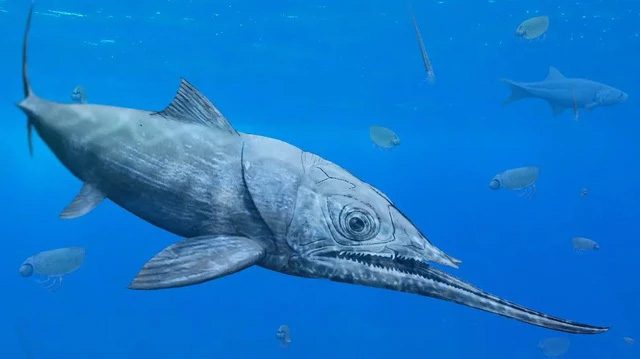The Devonian sea monster named “Alienacanthus” has been identified as the creature with the most dangerous bite ever known.
The name Alienacanthus, meaning “alien thorny monster,” already hints at the peculiarity of this creature that once terrorized the ancient oceans.
The “alien” sea monster Alienacanthus – Photo: Beat Scheffold and Christian Klug
In this context, “acanthus” refers to a spiny plant found in the Mediterranean region, which was chosen for the name because the fossilized jaw collected by scientists is also adorned with spines—actually teeth—similar to that plant.
Moreover, its lower jaw, filled with teeth, is unusually slender and long, and according to a recent study published in the scientific journal Royal Society Open Science, it is capable of delivering the most terrifying bite ever recorded.

Fossil of Alienacanthus – (Photo: Melina Jobbins and Christian Klug).
The fossil of Alienacanthus was actually excavated in Poland in 1957, but until now, thanks to modern techniques, its full shape and the danger it posed have been revealed.
Dating results indicate that Alienacanthus belongs to the Devonian period, a geological era that lasted 60 million years from the end of the Silurian period 419 million years ago until the start of the Carboniferous period around 359 million years ago.
This was also a crucial era for global fauna: it was the age when some ancient sea monsters began to evolve to live on land, becoming four-legged animals.
According to paleontologist Melina Jobbins from the University of Zurich (Switzerland), writing for The Conversation, the new findings about Alienacanthus have set a new record regarding the actual shape that Devonian sea monsters might have possessed.
In addition to the specimen found in Poland, several other fossils in Morocco have also been identified as belonging to this species of sea monster.
During the Devonian period, these two countries were located on the northeastern and southern coasts of a vast supercontinent. This implies that Alienacanthus was widely distributed across the superocean of that time.
The sea monster has also been identified as belonging to a group of placoderm fish, which were the first vertebrates with jaws. However, no species from this group has a face as “alien” as Alienacanthus.


















































